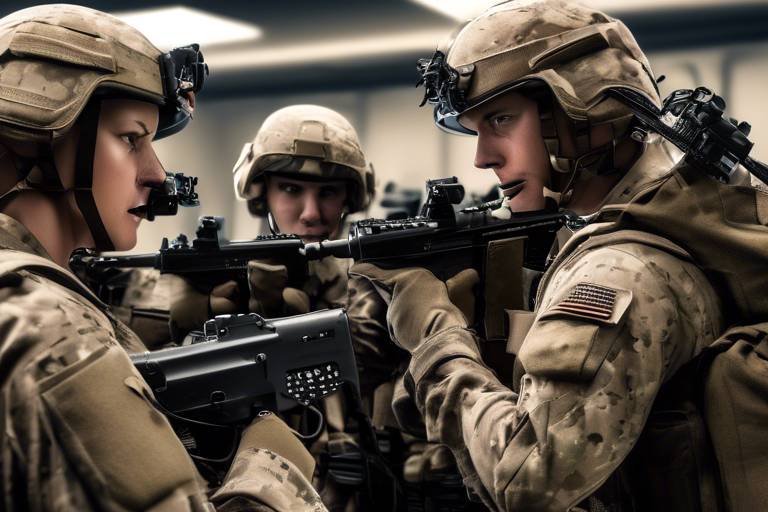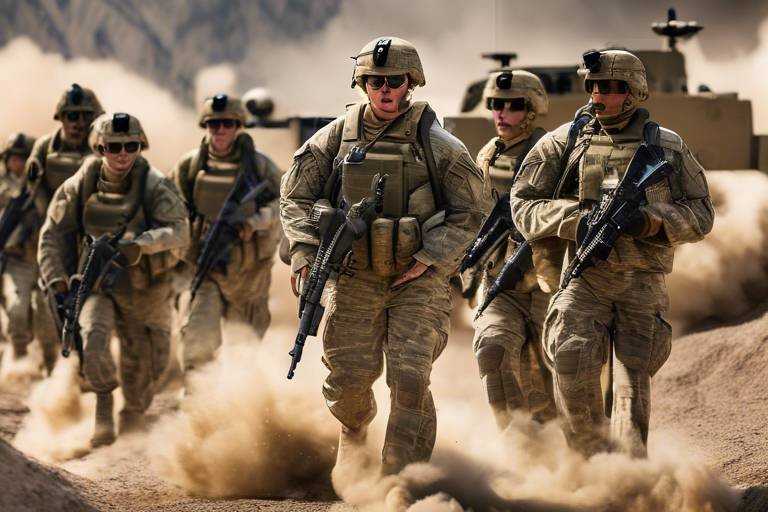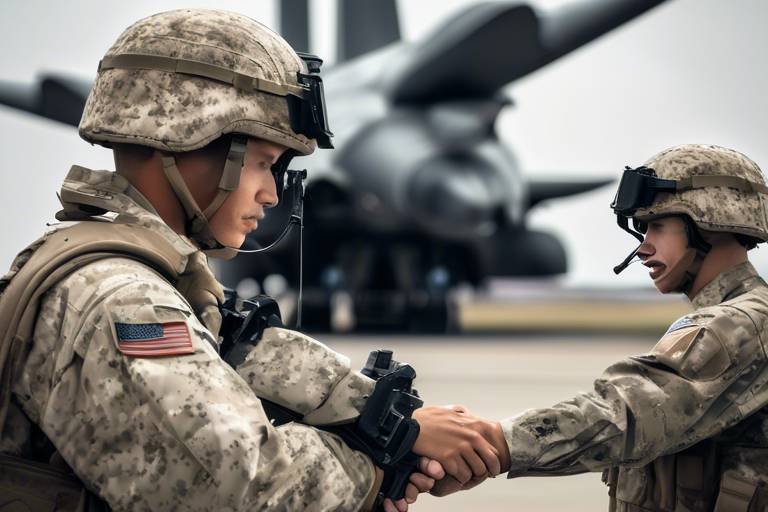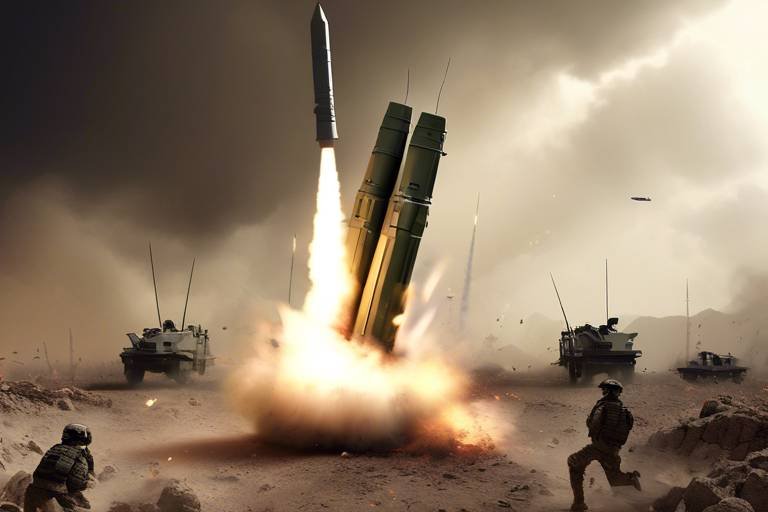Understanding the Importance of Training in Advanced Defense Systems
In today's world, where threats can emerge from any corner of the globe, the significance of training in advanced defense systems cannot be overstated. Imagine a soldier stepping into a battlefield without the necessary skills or knowledge—it's a recipe for disaster. Training is not just an optional add-on; it is the backbone of military readiness and operational success. With the increasing complexity of defense technologies, the need for comprehensive training programs has never been more critical. This article delves into the various dimensions of training in defense systems, emphasizing how it enhances personnel readiness, integrates cutting-edge technology, and ultimately fortifies national security.
At its core, training equips defense personnel with the skills and confidence necessary to handle real-world scenarios effectively. It is akin to preparing for a marathon; without the right training, even the best athletes can falter. Training ensures that personnel are not only familiar with advanced systems but can also operate them under pressure. This preparedness is crucial, as the stakes are incredibly high—our national security is often on the line. When personnel are well-trained, they can execute missions with precision, respond to threats swiftly, and adapt to the dynamic nature of modern warfare.
As technology evolves, so do training methodologies. Modern training programs increasingly incorporate advanced technologies such as simulations and virtual reality (VR). These tools provide personnel with realistic experiences that enhance their understanding and operational capabilities in complex defense environments. Think of it as a pilot training in a flight simulator; it allows for practice in a risk-free setting, which is invaluable. With the integration of these technologies, personnel can engage in scenarios that mimic real-life challenges, honing their skills without the associated risks of live training.
Simulation-based training is a game changer in defense preparation. It allows personnel to engage in realistic scenarios without the physical dangers that come with live exercises. For instance, during a simulation, a soldier can practice making split-second decisions in a controlled environment, which significantly enhances their decision-making skills and technical proficiency. The ability to repeat scenarios until mastery is achieved is one of the most significant advantages of simulation-based training.
Virtual reality takes training to another level by offering immersive experiences. Imagine donning a VR headset and being transported to a battlefield where every sound, sight, and even the feel of the environment is simulated. This level of immersion drastically improves situational awareness and response times. Personnel can practice navigating complex terrains, engaging with potential threats, and making tactical decisions—all from the safety of a training facility. The benefits are clear: enhanced preparedness leads to improved operational outcomes.
Another compelling reason to embrace simulation-based training is its cost-effectiveness. Traditional training methods can be expensive, involving significant expenses related to equipment, personnel, and logistics. In contrast, simulations allow for high-quality training experiences at a fraction of the cost. This financial efficiency means that defense organizations can allocate resources more effectively, ensuring that personnel receive the best possible training without breaking the bank.
To ensure that training programs are effective, robust assessment and evaluation methods are essential. These methods help measure the success of training initiatives and ensure that personnel meet the required standards. Regular evaluations can uncover areas for improvement, allowing organizations to fine-tune their training programs. After all, training is not a one-and-done affair; it requires ongoing assessment to adapt to evolving challenges and technologies.
In the rapidly changing landscape of defense, continuous learning and adaptation are non-negotiable. Personnel must stay updated on new technologies and strategies to maintain their effectiveness. Ongoing training programs are vital for keeping defense personnel proficient in the latest advancements and techniques. This culture of learning fosters adaptability within defense organizations, ensuring that they can respond effectively to new threats.
Just as athletes train consistently to maintain peak performance, defense personnel must engage in ongoing training to stay sharp. This commitment to continuous learning not only enhances individual skills but also contributes to the overall effectiveness of the defense force. It’s about building a resilient team that can tackle any challenge head-on.
Implementing feedback mechanisms is another critical aspect of effective training. By gathering insights from personnel about their training experiences and performance, organizations can refine their programs. This ensures that training remains relevant and effective in addressing emerging challenges. A feedback loop creates a dynamic training environment where continuous improvement is the norm.
Ultimately, effective training is directly correlated with operational success. Well-trained personnel can execute missions more efficiently, respond to threats swiftly, and adapt to changing circumstances in the field. In a world where every second counts, the difference between success and failure can often hinge on the quality of training received. Investing in comprehensive training programs is not just a strategic choice; it's a necessity for ensuring national security.
- Why is training in advanced defense systems important?
Training is essential for ensuring that personnel are prepared to operate advanced systems effectively and respond to real-world scenarios. - How does technology enhance training?
Technologies like simulations and virtual reality provide realistic training experiences that improve decision-making and operational capabilities. - What are the benefits of simulation-based training?
Simulation-based training allows for realistic practice without the risks of live training, enhancing skills and proficiency in a controlled environment. - How can organizations assess training effectiveness?
Through robust evaluation methods, organizations can measure training success and refine programs based on personnel feedback and performance.

The Role of Training in Defense Readiness
When it comes to national security, the importance of training in defense readiness cannot be overstated. Imagine a world where military personnel are not prepared for the unexpected. It would be like sending a soldier into battle without a weapon. Training equips defense personnel with the skills and knowledge necessary to respond effectively to real-world scenarios. It enhances their confidence and ensures they can operate advanced systems proficiently during critical operations.
In the face of evolving threats, having a well-trained military is paramount. Training prepares personnel not just to react, but to anticipate challenges. Are they ready to face cyber threats, unmanned aerial vehicles, or even unconventional warfare? The answer lies in their training. A solid training program can mean the difference between success and failure in the field. It creates a foundation upon which personnel can build their tactical and technical skills, ultimately contributing to the overall operational efficiency of the defense forces.
Moreover, training is not just about individual skills; it's about team dynamics. In many operations, success hinges on the ability of teams to work together seamlessly. Through rigorous training exercises, personnel learn to communicate effectively, trust one another, and execute complex maneuvers as a cohesive unit. This level of preparedness is crucial, especially in high-stakes environments where every second counts.
Consider the following aspects that highlight the significance of training in defense readiness:
- Enhanced Decision-Making: Training helps personnel make quick, informed decisions under pressure.
- Increased Adaptability: Regular training ensures that personnel can adjust to new technologies and tactics.
- Improved Morale: A well-trained force tends to have higher confidence and morale, which can significantly affect performance.
In summary, training is the backbone of defense readiness. It empowers personnel to face challenges head-on, enhances teamwork, and fosters a culture of continuous improvement. Without effective training programs, defense forces would be ill-equipped to handle the complexities of modern warfare, leaving national security at risk.

Technology Integration in Training Programs
In today's fast-paced world, the integration of technology into training programs is not just a trend; it's a necessity. Advanced defense systems are becoming increasingly complex, and keeping up with these advancements requires innovative training methods. By incorporating modern technologies, defense organizations can create training environments that are not only realistic but also engaging and effective. Imagine a scenario where personnel can practice their skills in a virtual battlefield, experiencing the sights and sounds of real combat without ever leaving the training facility. This is the power of technology integration in defense training.
One of the most significant advancements in this area is the use of simulation-based training. These simulations allow defense personnel to immerse themselves in lifelike scenarios, honing their skills without the risks associated with live training exercises. For instance, a pilot can practice flying a fighter jet in various weather conditions and combat situations, all within a safe, controlled environment. This kind of training enhances decision-making skills and technical proficiency, preparing personnel for the unpredictable nature of real-world operations.
Simulation-based training is revolutionizing how defense personnel prepare for their roles. By engaging in realistic scenarios, individuals can practice their responses to various challenges, from technical malfunctions to enemy engagements. This method not only boosts their confidence but also sharpens their tactical thinking. The controlled environment allows for mistakes to be made without dire consequences, fostering a learning atmosphere where personnel can grow and improve.
Virtual reality (VR) training takes this concept a step further. It offers an immersive experience that can make training feel incredibly real. Personnel can walk through a simulated environment, interact with virtual objects, and even engage with AI-driven opponents. This level of immersion enhances situational awareness and improves response times in high-pressure situations. For example, imagine a soldier navigating through a virtual cityscape, identifying potential threats, and making split-second decisions. This kind of training prepares them for the chaos of actual combat, where every second counts.
Another compelling reason to adopt technology in training programs is the cost-effectiveness of simulations. Traditional training methods often require significant resources, including personnel, equipment, and logistics. However, with simulation-based training, many of these costs can be reduced. For example, a single simulation setup can provide training for multiple personnel without the need for extensive physical resources. This not only saves money but also allows for more frequent training sessions, ensuring that personnel remain proficient in their skills.
In summary, the integration of technology into training programs is transforming the landscape of defense training. By leveraging simulation-based training and virtual reality, defense organizations can create more effective, efficient, and engaging training experiences. As technology continues to evolve, so too will the methods used to prepare our defense personnel for the challenges they face. The future of training is not just about keeping up; it's about staying ahead.
- What types of technology are commonly used in defense training?
Common technologies include simulation software, virtual reality systems, and augmented reality tools that create immersive training environments. - How does simulation-based training improve decision-making skills?
Simulation-based training places personnel in realistic scenarios where they must make quick decisions, enhancing their ability to think critically under pressure. - Is virtual reality training cost-effective?
Yes, VR training reduces costs associated with equipment and logistics, allowing for more frequent and varied training sessions. - How often should ongoing training occur?
Ongoing training should be a regular part of personnel development, ideally incorporating new technologies and strategies as they emerge.

Simulation-Based Training
When it comes to preparing defense personnel for the unpredictable nature of real-world operations, stands out as a game-changer. Imagine stepping into a virtual battlefield where you can hone your skills without the risks that come with live training exercises. This innovative approach allows military and defense teams to engage in realistic scenarios that closely mimic what they might face in actual combat situations. The beauty of simulation-based training lies in its ability to create a safe yet challenging environment where personnel can experiment, make mistakes, and learn from them without any real-world consequences.
One of the most significant advantages of simulation-based training is its capacity to enhance decision-making skills. In a controlled environment, personnel can practice responding to various situations, from tactical maneuvers to emergency responses. This kind of training not only builds confidence but also fosters a deeper understanding of the advanced systems they will be operating. For instance, during a simulated mission, a team might face unexpected challenges that require quick thinking and adaptability. By navigating these scenarios, they can refine their skills and prepare for the unpredictability of actual missions.
Moreover, simulation-based training is particularly beneficial in developing technical proficiency. Personnel can familiarize themselves with complex equipment and systems through hands-on practice in a virtual setting. This level of engagement is crucial as it allows them to understand the nuances of advanced defense technologies without the pressure of real-time stakes. As they become more adept at using these systems, their overall operational efficiency improves, leading to better outcomes during actual missions.
To illustrate the effectiveness of simulation-based training, consider a recent study that compared traditional training methods with simulation-based approaches. The results revealed that personnel who underwent simulation training demonstrated a significant increase in both their technical skills and confidence levels. In fact, 85% of participants reported feeling more prepared for real-life scenarios after engaging in simulated exercises. This statistic underscores the critical role that simulation plays in modern defense training programs.
In addition to enhancing skills, simulation-based training is also a cost-effective solution for defense organizations. Traditional training methods often require extensive resources, including personnel, equipment, and logistical support. In contrast, simulations can be conducted with fewer resources while still providing high-quality training experiences. By reducing the need for live training exercises, organizations can allocate their budgets more effectively, ensuring that they invest in the most impactful training solutions available.
Overall, simulation-based training is not just a trend; it's a necessity in the ever-evolving landscape of defense operations. By leveraging advanced technologies to create immersive training experiences, defense organizations can ensure that their personnel are not only well-prepared but also equipped to handle the complexities of modern warfare. As we continue to advance technologically, the importance of simulation-based training will only grow, helping to maintain the readiness and effectiveness of our defense forces.
- What is simulation-based training? Simulation-based training uses virtual environments to replicate real-world scenarios, allowing personnel to practice skills without the risks associated with live training.
- How does simulation training improve decision-making? It allows individuals to engage in realistic scenarios, enhancing their ability to think critically and respond quickly to unexpected challenges.
- Is simulation-based training cost-effective? Yes, it often requires fewer resources than traditional methods, making it a financially viable option for defense organizations.
- What are the benefits of using advanced technologies in training? Technologies like virtual reality provide immersive experiences that improve situational awareness and technical proficiency.

Benefits of Virtual Reality Training
Virtual reality (VR) training has emerged as a revolutionary approach in the defense sector, providing unparalleled benefits that traditional training methods simply cannot match. Imagine stepping into a lifelike environment where every sound, sight, and sensation is meticulously crafted to mimic real-world scenarios. This immersive experience allows defense personnel to practice their skills in a safe yet realistic setting, enhancing their readiness for actual operations. One of the most significant advantages of VR training is its ability to improve situational awareness. Personnel can experience complex scenarios that require quick thinking and decisive action, all while being monitored and guided by experienced instructors.
Furthermore, VR training can significantly reduce the costs associated with traditional training methods. By utilizing virtual environments, organizations can minimize expenses related to physical equipment, travel, and logistics. For instance, consider the cost of using live ammunition or specialized vehicles for training exercises. With VR, these costs are dramatically lowered, allowing for more frequent training sessions without breaking the bank. This not only makes training more accessible but also ensures that personnel can engage in continuous practice, which is crucial for skill retention.
Another remarkable benefit of VR training is its adaptability. As the field of defense evolves and new technologies emerge, VR training programs can be easily updated to reflect these changes. This flexibility ensures that personnel are always learning the most current tactics, techniques, and procedures. For example, if a new defense system is introduced, a VR training module can be developed quickly, allowing personnel to familiarize themselves with the new technology without the need for extensive physical resources.
Moreover, VR training fosters teamwork and communication among personnel. Many VR training scenarios are designed for group participation, encouraging collaboration and enhancing interpersonal skills. This is essential in defense operations where teamwork can mean the difference between success and failure. By practicing together in a virtual environment, personnel can build trust and improve their ability to work as a cohesive unit.
In conclusion, the benefits of virtual reality training in the defense sector are numerous and profound. From enhancing situational awareness and reducing costs to providing adaptability and fostering teamwork, VR training stands out as a game-changer. As we continue to advance technologically, embracing VR training will undoubtedly lead to more prepared and effective defense personnel, ultimately strengthening national security.

Cost-Effectiveness of Simulations
When it comes to training in advanced defense systems, the stands out as a game-changer. Traditional training methods often involve significant expenses related to equipment, fuel, personnel, and logistics. In contrast, simulations provide a unique opportunity to cut these costs dramatically while maintaining a high standard of training quality. Imagine being able to replicate complex scenarios without the need for extensive resources – that’s where simulations come into play.
One of the primary advantages of simulation-based training is its ability to create realistic environments without the associated risks. For instance, in a live-fire exercise, the costs can skyrocket due to ammunition usage, maintenance of equipment, and safety measures. However, with simulation technology, defense personnel can engage in lifelike scenarios that mimic real-world conditions, all while being in a safe and controlled environment. This not only reduces costs but also enhances the learning experience.
Moreover, simulations allow for repetition and variation in training exercises, which is vital for mastering skills. Personnel can practice the same scenario multiple times, refining their techniques and decision-making processes without incurring additional costs each time. This is akin to a musician practicing a piece of music repeatedly until they can perform it flawlessly. The more they practice, the more proficient they become.
To illustrate the cost benefits of simulation training, consider the following comparison:
| Training Method | Estimated Cost per Session | Key Expenses |
|---|---|---|
| Live Training | $10,000 | Ammunition, Equipment Maintenance, Personnel Costs |
| Simulation Training | $2,000 | Software Licensing, Hardware Maintenance |
This table clearly demonstrates that simulation training can be a fraction of the cost of traditional methods. Additionally, the savings can be allocated toward enhancing the training programs themselves, such as incorporating more advanced technology or hiring experienced instructors.
In conclusion, the not only leads to substantial financial savings but also enhances the overall training experience for defense personnel. By embracing this innovative approach, defense organizations can ensure that their teams are well-prepared, highly skilled, and ready to face any challenges that may arise in the field.
- What are the main advantages of simulation-based training? Simulation-based training provides a safe environment, reduces costs, and allows for repeated practice of complex scenarios.
- How does simulation training compare to traditional training methods? Simulation training is generally more cost-effective, safer, and allows for greater flexibility in training exercises.
- Can simulations replicate real-world scenarios accurately? Yes, modern simulations use advanced technology to create realistic environments that closely mimic real-world conditions.

Assessment and Evaluation Methods
When it comes to ensuring that defense personnel are ready for the unpredictable nature of real-world operations, play a pivotal role. These methods are not just about ticking boxes; they are essential for measuring the effectiveness of training programs and ensuring that personnel are equipped to handle the challenges they may face in the field. Think of it as a performance review for soldiers, where their skills, knowledge, and readiness are put under the microscope.
One of the most effective ways to assess training success is through performance evaluations. These evaluations often combine both theoretical knowledge and practical skills, allowing instructors to gauge how well personnel can apply what they've learned. For instance, during a simulated combat scenario, evaluators can observe how quickly and accurately personnel respond to threats, making note of their decision-making processes and teamwork abilities.
Additionally, feedback mechanisms are integral to the assessment process. After each training session, personnel should have the opportunity to provide input on what they found helpful and what they struggled with. This feedback loop not only helps refine training programs but also encourages a culture of open communication within defense organizations. When personnel feel their opinions are valued, they are more likely to engage fully in training and seek to improve their skills.
Moreover, incorporating technology into assessment methods can yield invaluable insights. For example, data analytics can be employed to track performance over time, identifying trends and areas that require additional focus. By analyzing this data, organizations can tailor their training programs to better meet the needs of their personnel. Imagine having a dashboard that shows you exactly where your team excels and where they need more practice—this is the future of defense training.
To summarize, effective assessment and evaluation methods are crucial for ensuring that defense personnel are not just trained but are also ready to face the realities of their roles. By combining performance evaluations, feedback mechanisms, and advanced technology, organizations can create a robust framework that supports continuous improvement and operational readiness.
- What are the key components of assessment methods in defense training? Assessment methods typically include performance evaluations, feedback mechanisms, and the use of technology for data analysis.
- How can feedback improve training programs? Feedback allows organizations to refine training based on real experiences and performance, ensuring that training remains relevant and effective.
- Why is technology important in assessment? Technology helps track performance over time and provides data-driven insights that can enhance training effectiveness.
- How often should assessments be conducted? Assessments should be ongoing, with regular evaluations after training sessions to ensure personnel are consistently improving and adapting.

Continuous Learning and Adaptation
In the ever-evolving landscape of defense, where technology and threats are in a constant state of flux, continuous learning and adaptation emerge as the cornerstones of effective military readiness. It's akin to a chess game, where each move must be calculated and adaptable to the opponent's strategy. Just as a chess player studies various tactics and scenarios, defense personnel must engage in ongoing education to stay ahead of potential threats.
Imagine a world where soldiers are not just trained once and left to fend for themselves. Instead, they are immersed in a culture of perpetual learning, where every experience contributes to their growth and adaptability. This approach not only enhances individual capabilities but also fortifies the entire defense apparatus. The importance of ongoing training programs cannot be overstated; they ensure that defense personnel are not only aware of the latest technological advancements but are also proficient in utilizing them effectively.
Moreover, the rapid pace of technological advancement means that skills can become obsolete very quickly. For instance, consider the rise of artificial intelligence and machine learning in defense systems. Personnel trained solely on outdated methodologies may struggle to leverage these new technologies effectively. Therefore, ongoing training is essential to bridge this gap, ensuring that all personnel are equipped with the necessary skills to operate cutting-edge systems.
Another vital aspect of continuous learning is the implementation of feedback mechanisms. These systems allow organizations to gather insights from personnel regarding their training experiences and performance. By analyzing this feedback, defense organizations can refine their training programs, making them more relevant and effective. It's like tuning a musical instrument; even the smallest adjustments can lead to a harmonious performance in the field.
Additionally, the integration of advanced technologies into training programs enhances the learning experience. For example, the use of virtual reality and simulation-based training not only provides engaging and realistic environments but also allows for immediate feedback and assessment. This iterative process of learning and adaptation is crucial for developing the agility needed to respond to dynamic operational challenges.
Ultimately, the goal of continuous learning and adaptation is to create a resilient force capable of thriving in uncertainty. Just as a river carves its path through the landscape, adapting to the terrain, defense personnel must be flexible and responsive to the ever-changing demands of their roles. By fostering a culture of continuous improvement and learning, defense organizations can ensure that their personnel are always prepared to tackle the challenges of today and tomorrow.
- Why is continuous learning important in defense? Continuous learning ensures that personnel remain proficient in the latest technologies and strategies, enhancing their operational effectiveness.
- How can feedback mechanisms improve training programs? Feedback mechanisms allow organizations to refine training based on real experiences, ensuring that programs remain relevant and effective.
- What role does technology play in ongoing training? Technology, such as virtual reality and simulations, enhances training by providing realistic scenarios and immediate feedback.

Importance of Ongoing Training
In the fast-paced world of defense, where threats can evolve overnight, the cannot be overstated. Just think about it: imagine a soldier who trained for combat five years ago, using equipment and tactics that have since been updated or replaced. Wouldn’t you want that soldier to be as prepared as possible for the challenges they might face today? Ongoing training ensures that personnel stay sharp, informed, and ready to tackle any situation that arises. It’s not just about maintaining skills; it’s about enhancing them.
Moreover, ongoing training fosters a culture of continuous improvement within defense organizations. By regularly updating training programs, organizations can incorporate the latest technologies and strategies, ensuring that personnel are not just competent but also confident in their abilities. This adaptability is crucial because, in defense, the stakes are incredibly high. A well-trained soldier can mean the difference between mission success and failure, and sometimes, even life and death.
Additionally, ongoing training is essential for team cohesion. When personnel engage in regular training exercises together, they develop a stronger bond and better understanding of each other’s strengths and weaknesses. This synergy can lead to more effective teamwork in real-world operations. Just like a well-rehearsed sports team, defense units that train together can anticipate each other’s moves, leading to smoother operations and quicker response times.
To illustrate the significance of ongoing training, consider the following key points:
- Adaptation to New Technologies: As technology advances, so do the tools and systems used in defense. Ongoing training helps personnel adapt to these changes swiftly.
- Enhanced Decision-Making: Regular training scenarios allow personnel to practice critical thinking and decision-making in high-pressure situations, improving their performance during actual missions.
- Increased Morale: Continuous learning opportunities can boost morale, as personnel feel invested in their growth and are more likely to stay engaged and motivated.
In summary, ongoing training is not just a checkbox on a to-do list; it’s a vital component of defense readiness. By committing to lifelong learning, defense organizations can ensure that their personnel are not only prepared for today’s challenges but are also equipped to face the uncertainties of tomorrow. In a world where the unexpected is the norm, being proactive in training is the best strategy to maintain a strong defense.

Feedback Mechanisms
In the realm of advanced defense systems, play a pivotal role in refining training programs and enhancing overall operational effectiveness. Imagine a well-oiled machine; each cog and gear must function in harmony to achieve the desired outcome. Similarly, feedback loops ensure that the training provided is not only relevant but also tailored to meet the evolving needs of defense personnel. By systematically collecting and analyzing feedback, organizations can pinpoint areas for improvement, adapt training content, and ultimately foster a culture of continuous enhancement.
One of the most effective ways to gather feedback is through after-action reviews (AARs). These reviews allow personnel to reflect on their experiences during training exercises, discussing what went well and what could be improved. This process not only encourages open communication but also empowers individuals to take ownership of their learning. Furthermore, integrating technology into feedback collection can streamline this process. For instance, using mobile applications or online platforms enables personnel to provide real-time feedback, making it easier to capture insights immediately after training sessions.
Moreover, feedback mechanisms can be categorized into several key areas:
- Peer Reviews: Colleagues can offer valuable insights based on their observations, fostering a collaborative learning environment.
- Instructor Assessments: Instructors can evaluate trainee performance and provide constructive feedback, guiding personnel towards improvement.
- Self-Assessment: Encouraging personnel to self-evaluate their skills and knowledge promotes self-awareness and accountability.
By implementing these mechanisms, defense organizations can create a robust feedback system that not only addresses immediate training needs but also anticipates future challenges. The ultimate goal is to ensure that personnel are not just prepared for today's threats but are also equipped to tackle the uncertainties of tomorrow's battlefield.
In conclusion, the integration of effective feedback mechanisms into training programs is essential for maintaining a competitive edge in defense operations. As the landscape of threats evolves, so too must the strategies and training methodologies employed. By valuing feedback and fostering an environment of continuous improvement, defense organizations can enhance their operational readiness and ensure that personnel are always at the top of their game.
- What are feedback mechanisms in defense training? Feedback mechanisms are processes that collect insights from personnel regarding their training experiences to improve future training programs.
- Why are after-action reviews important? AARs provide a structured opportunity for personnel to reflect on their training, allowing for constructive discussions that enhance learning and performance.
- How can technology improve feedback collection? Technology, such as mobile apps and online platforms, facilitates real-time feedback, making it easier to gather insights immediately after training sessions.
- What role does self-assessment play in training? Self-assessment encourages personnel to evaluate their own skills and knowledge, fostering personal accountability and awareness of areas needing improvement.

The Impact of Training on Operational Success
When we talk about the impact of training on operational success in defense systems, we’re diving into a realm where preparation meets execution. Imagine a well-oiled machine; every component needs to function flawlessly for the entire system to perform at its best. In the context of defense, this machine is made up of highly trained personnel who can react swiftly and effectively to any situation that arises. Effective training is not just a checkbox on a to-do list; it’s the backbone of operational readiness.
Consider this: during a mission, the stakes are incredibly high. Personnel must be able to execute their roles with precision and confidence. This is where the importance of training becomes glaringly obvious. Well-trained individuals can make split-second decisions that could mean the difference between success and failure. They are equipped with the skills necessary to handle advanced technologies and respond to threats in real-time. The correlation between rigorous training and operational success is not just a theory; it’s a proven fact.
Moreover, the ability to adapt to changing circumstances in the field is crucial. Training programs that emphasize real-world scenarios allow personnel to experience the unpredictability of actual operations. This experience fosters a mindset of adaptability and quick thinking. For instance, during joint exercises, teams can simulate various threat levels and operational environments, preparing them for anything they might face in the field. The more varied the training, the better the defense personnel can handle unexpected challenges.
To illustrate the impact of training on operational success, consider the following table that outlines key benefits of effective training programs:
| Benefit | Description |
|---|---|
| Enhanced Decision-Making | Training sharpens critical thinking skills, enabling personnel to make informed decisions quickly. |
| Improved Team Coordination | Regular training fosters teamwork and communication, essential for mission success. |
| Increased Confidence | Personnel who train rigorously are more confident in their abilities, which translates to better performance. |
| Operational Readiness | Continuous training ensures personnel are always prepared for deployment and operational challenges. |
In addition to these benefits, the impact of training on morale should not be overlooked. When personnel feel competent and prepared, their confidence boosts their morale, leading to a more cohesive and effective unit. This sense of readiness also contributes to a culture of excellence within the organization, where individuals strive to improve continuously.
To wrap it up, the impact of training on operational success in defense systems is profound. It’s not merely about following protocols; it’s about creating a culture where every team member is empowered, prepared, and ready to face the unknown. The better trained the personnel, the more successful the operations, ensuring that national security remains a top priority.
- Why is training essential for defense personnel? Training equips personnel with the necessary skills and knowledge to handle advanced defense systems effectively.
- How does simulation-based training enhance readiness? Simulation-based training provides realistic scenarios that help personnel develop decision-making skills without the risks of live training.
- What role does continuous learning play in defense? Continuous learning ensures that personnel stay updated on new technologies and strategies, maintaining their effectiveness in dynamic environments.
- Can training impact morale within defense units? Yes, effective training boosts confidence and morale, fostering a culture of excellence and teamwork.
Frequently Asked Questions
- What is the significance of training in advanced defense systems?
Training plays a crucial role in ensuring that defense personnel are well-prepared for real-world scenarios. It enhances their skills, boosts their confidence, and ultimately contributes to national security by ensuring that they can effectively operate advanced defense systems during critical operations.
- How do modern training programs integrate technology?
Modern training programs leverage advanced technologies such as simulations and virtual reality to create realistic training environments. This integration allows personnel to gain hands-on experience without the risks associated with live training, thus improving their decision-making skills and technical proficiency.
- What are the benefits of simulation-based training?
Simulation-based training offers numerous benefits, including the ability to engage in realistic scenarios, enhance decision-making skills, and improve technical proficiency in a controlled environment. It minimizes risks while providing high-quality training experiences that are crucial for effective defense operations.
- Why is ongoing training important for defense personnel?
Ongoing training is essential because the defense field is constantly evolving with new technologies and strategies. Continuous learning helps personnel stay updated, ensuring that they remain proficient in the latest advancements and can adapt to emerging challenges effectively.
- What role do feedback mechanisms play in training programs?
Feedback mechanisms are vital for refining training programs. They allow organizations to gather insights based on personnel experiences and performance, ensuring that training remains relevant and effective in addressing the dynamic challenges faced in defense operations.
- How does effective training impact operational success?
Effective training directly correlates with operational success. Well-trained personnel can execute missions more efficiently, respond swiftly to threats, and adapt to changing circumstances in the field, significantly enhancing overall mission effectiveness.



















